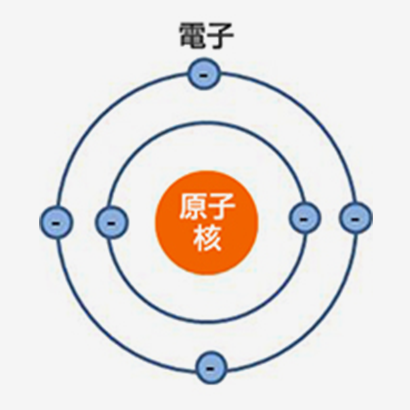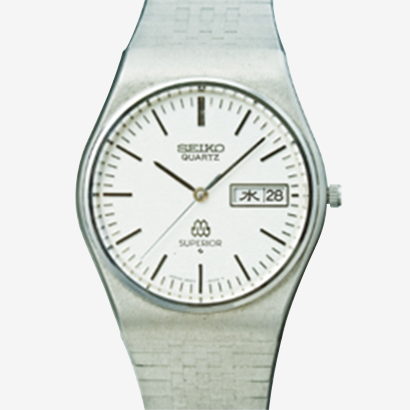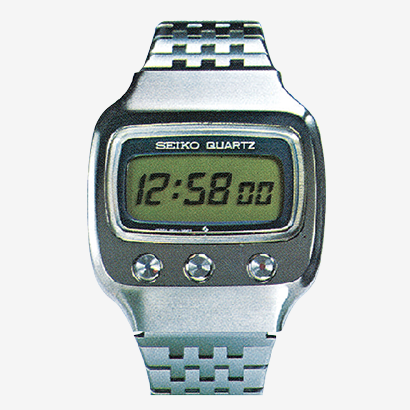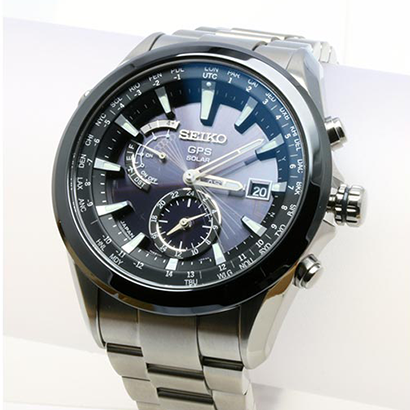Electronic wristwatches

From the late 1950s, watch manufacturers began to compete fiercely in the development of high-precision watches, pitting their products against each other in competitions held by observatories in Switzerland to judge timepiece precision. To increase precision, they had to increase the oscillation frequency of the balance wheel, which required a strong mainspring. But since the speed of the gears would also be increased, this would lead to increased wear. Watch manufacturers made various developments such as powerful mainsprings, durable hairsprings, lubricants that would not easily be spattered about by fast-moving gears, and high-precision components that could run smoothly with very little power. Around the beginning of the 1960s, 8-beat watches became widespread on the market. With this and the needs of the time, such as railway developments and advanced factory production management, the competition in precision became even more fierce.
Amidst this fierce competition, in 1966 the Swiss company Girard-Perregaux launched the world’s first mass-produced 10-beat wristwatch. Following this, Seiko launched its own 10-beat wristwatches: the Lord Marvel 36000 in 1967, and the Grand Seiko V.F.A in 1969. Up to 1970, 10-beat watches from all of the various watch manufacturers entered the market. However, the watch industry’s pursuit of high precision did not remain limited to mechanical watches, and a furious competition commenced in the development of electronic wristwatches. The launch of the Hamilton Electric Watch, a battery-powered watch that operated with a balance wheel, in 1957 by the Hamilton Watch Company in America and the launch of the Accutron tuning fork watch in 1960 by Bulova sent shockwaves through the timepiece industry around the world. Bulova’s tuning fork watch vibrated at 360 Hz and was accurate to within two seconds per day, but the pursuit of even higher precision led to the age of quartz watches.
Development of quartz timepieces
A quartz timepiece is one that utilizes a quartz crystal’s property of oscillating at a precise frequency when a voltage is applied to it. The quartz clock was invented in America by Warren Marrison (1896 - 1980) in 1927. In 1937, Issac Koga (1899 - 1982) developed Japan’s first quartz clock. By using the precise vibration frequency of a quartz oscillator as the standard for keeping time, in place of the conventional pendulum or balance wheel, the precision of timepieces increased dramatically.
Seiko undertook the miniaturization and practical application of quartz timepieces. In 1958 Seiko developed a quartz clock for use in broadcasting stations, which was implemented in 1959, but it was about the size of a large locker. To create a quartz watch, Seiko would need to reduce the size to 1/300,000 the size of this clock. In the same year, Seiko conducted a research project into various types of timepieces, such as balance wheels, tuning forks, and quartz mechanisms. Although they would be the most difficult of all to develop, Seiko determined that quartz timepieces, having the highest precision, were the technology of the future, and focused its efforts in that direction.
In 1960, Seiko resolved to become the official timer for the 1964 Tokyo Olympics and began in earnest to develop a tabletop quartz timer for use in the Olympics. The first model of a tabletop clock was completed in 1962. Seiko continued to make improvements, and in 1964 it launched the Crystal Chronometer, which was used as the primary clock of the Tokyo Olympics. Seiko completed prototypes for a pocket watch in 1966 and a wristwatch in 1967. A policy was soon laid out to achieve commercialization before the end of the decade, and development rapidly accelerated.
The world’s first quartz wristwatch emerges

On December 25, 1969, Seiko launched the world’s first quartz wristwatch—the Seiko Quartz Astron 35SQ. The price was 450,000 yen, around the same price as some of the popular cars of the time. At a time when accuracy of anywhere from a few seconds to a few dozen seconds per day was considered normal for high-precision mechanical wristwatches, accuracy of just ±0.2 seconds per day and accuracy of just ±5 seconds per month was astounding.
By releasing the technology, it had patented through its research, Seiko sparked a dramatic popularization of quartz wristwatches. The miniature, low-power-consumption, shock-resistant tuning-fork type quartz oscillator, the one-second ticking motion of the second hand to save power, the open-type stepping motor that enabled space-saving arrangement of the coil, stator, and rotor; the utilization of these technologies in Seiko’s watches made them the global standard. Although the Quartz Astron contained a quartz oscillator with a vibration frequency of 8,192 Hz, a frequency of 32,768 Hz became the standard for later quartz timepieces.
Seiko’s great achievement has been recognized by the IEEE (Institute of Electrical and Electronics Engineers) in the US, which has awarded the company both the Corporate Innovation Recognition Award in 2002 and a Milestone Award in 2004. The Quartz Astron is on permanent display at the Smithsonian Institution, and in 2014 it was recognized as a Mechanical Engineering Heritage in Japan. In fiscal year 2018 the Astron was registered as an Essential Historical Material for Science and Technology (also known as “Future Technology Heritage”) by Japan’s National Museum of Nature and Science.






